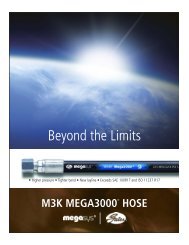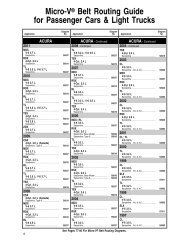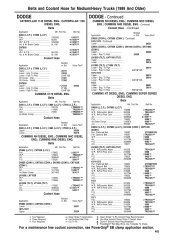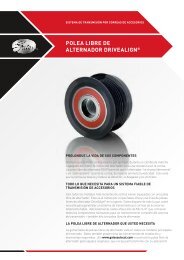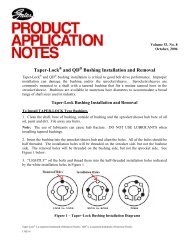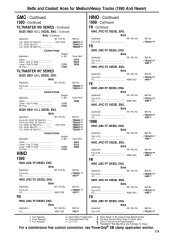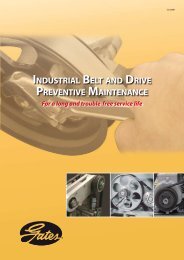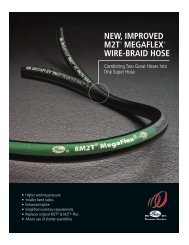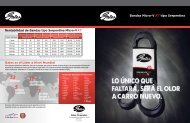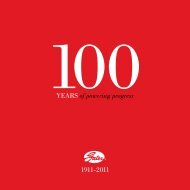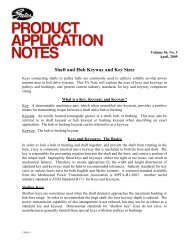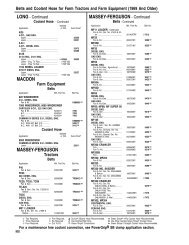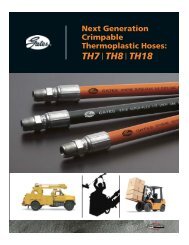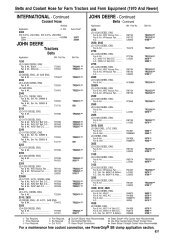PowerGrip® GT® Belt Drives
PowerGrip® GT® Belt Drives
PowerGrip® GT® Belt Drives
You also want an ePaper? Increase the reach of your titles
YUMPU automatically turns print PDFs into web optimized ePapers that Google loves.
Polyflex ® JB ® and Micro-V ® <strong>Belt</strong>s – Engineering<br />
X. <strong>Belt</strong> Pull and Bearing Loads<br />
<strong>Belt</strong> pull is the magnitude of force exerted on the<br />
sheaves by the belts. This force is often referred to<br />
as side load. Magnitude of the bearing load in<br />
driveR or driveN machines depends upon both the<br />
side load (shaft load) acting on the shaft and<br />
bearing locations with respect to side load. Side<br />
load is the combined load created by sheave weight<br />
and belt pull. In comparing these force components,<br />
the sheave weight is usually much less than belt<br />
pull and is typically ignored. However, if there is a<br />
critical application that requires exacting load<br />
information. Sheave weights will have to be<br />
included in the calculations. <strong>Belt</strong> pull is a function<br />
of these variables:<br />
1. Horsepower Transmitted – For the following<br />
given drive, horsepower is directly proportional to<br />
the belt pull; i.e., as the load increases, the belt<br />
pull also increases.<br />
2. <strong>Belt</strong> Speed – For the same horsepower, higher<br />
belt speed (larger sheave diameters) reduces belt<br />
pull.<br />
3. Arc of Contact – Reduced arc of contact (wrap)<br />
requires more tension to prevent belt slip. This<br />
increases the belt pull for the same horsepower<br />
load.<br />
4. Total Drive Installation Tension – Minimum<br />
tension is required to keep Polyflex JB and<br />
Micro-V belts from slipping. However, if the<br />
installation tension is excessively high, the belt<br />
pull also will be higher than desired.<br />
NOTE: Required belt pull is independent of the number of<br />
belts or ribs used on the drive. The number of belts or ribs only<br />
affects the amount of overhang from the center of belt pull to the<br />
bearings.<br />
After accurately calculating belt pull, the designer<br />
can size the shafts and bearings required for the<br />
driveR and driveN equipment. It is important that the<br />
designer check the capacity of the shafts and<br />
bearings on both the driveR and driveN.<br />
The driveR is usually an electric motor or engine.<br />
For electric motors, the belt pull is limited to an<br />
acceptable amount by either the recommended<br />
sheave diameters listed in Table 37 on Page 73 or<br />
by the minimum recommended diameters specified<br />
by the motor manufacturer.<br />
Many handbooks show belt pull formulas that differ<br />
from formulas and procedures described in this<br />
section. These differences are the result of shortcuts<br />
that either ignore or average factors such as the arc<br />
of contact correction factor. The Gates method<br />
results in accurate calculations of belt pull for drives<br />
operating at design loads and tensions.<br />
<strong>Belt</strong> tensions are based on a ratio between the<br />
tightside and slackside tensions. The design tension<br />
ratio for Polyflex JB drives is 5:1, and 4:1 for<br />
Micro-V, based upon 180° arc of contact. Design<br />
tension ratio is then corrected for the actual arc of<br />
contact.<br />
The equipment designer should recognize that belts<br />
can be tensioned up to 1.5 times the design tension.<br />
(See Section IV. <strong>Belt</strong> Tensioning on Page 78 and 79.<br />
This higher tension expedites belt seating, but does<br />
not exist for the life of the drive. Shafts and bearings<br />
must be designed to tolerate these higher tensions<br />
for a reasonable amount of time without sustaining<br />
damage.<br />
The following formulas are correct for Polyflex JB<br />
and Micro-V belt drives. When shaft load<br />
calculations are required, Gates recommends using<br />
the following formulas and procedures:<br />
<strong>Belt</strong> Pull Calculations<br />
Step 1 Calculate the Drive Tensions.<br />
<strong>Belt</strong> pull is the vector sum of T T and T S , the<br />
tightside and slackside tensions, respectively.<br />
Calculate these tensions using the formulas below.<br />
Formula 28<br />
T T = 41,250 (DHP) , lb.<br />
GV<br />
Formula 29<br />
T S = 33,000 (1.25 - K) (DHP) , lb.<br />
GV<br />
Formula 30<br />
T T = 44,000 (DHP) , lb.<br />
GV<br />
Formula 31<br />
T S = 33,000 (1.33 - K) (DHP) , lb.<br />
GV<br />
(Polyflex JB)<br />
(Polyflex JB)<br />
(Micro-V)<br />
(Micro-V)<br />
Where: T T = Tightside Tension, pounds<br />
Ts = Slackside Tension, pounds<br />
DHP = Design Horsepower<br />
V = <strong>Belt</strong> Speed (ft/min) = {(Pitch Diameter,<br />
in.) (rpm)} over 3.82<br />
G = Arc of contact correction factor, (Table<br />
33, Page 72.)<br />
Step 2 Find the Vector Sum of T T and T S .<br />
Calculate the magnitude and direction of the belt<br />
pull by summing the T T and T S vectors. The<br />
simplest method of calculating the belt pull vector is<br />
by graphical addition. After determining the belt pull<br />
vector, calculate true shaft loads by adding belt pull<br />
vectors to sheave weight vectors.<br />
A. If only the magnitude of belt pull is needed,<br />
numerical methods for vector additions are<br />
faster than the graphical approach. If both<br />
magnitude and direction of belt pull are<br />
required, the vector sum of T T and T S can be<br />
calculated by graphical vector addition as<br />
shown in Fig. 32. The T T and T S vectors are<br />
parallel to the tightside and slackside,<br />
respectively, and they should be drawn to a<br />
convenient scale; i.e. 1 in. = 100 lb.<br />
Fig. 32 shows the vector addition for belt pull<br />
on a motor shaft. Use the same procedures to<br />
determine the belt pull on the driveN shaft. This<br />
graphical illustration method should also be<br />
used for drives that have three or more sheaves<br />
or idlers.<br />
For two-sheave drives, belt pull on the driveR and<br />
driveN shafts is equal but opposite in direction. For<br />
drives using idlers, both magnitude and direction<br />
may be different.<br />
Figure 32 – Graphical Addition of T T and T S<br />
The World’s Most Trusted Name in <strong>Belt</strong>s, Hose & Hydraulics.<br />
85



